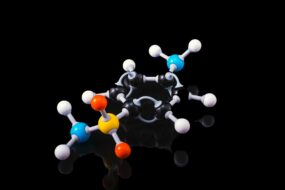Sumatriptan is the first selective 5-HT1D/1B receptor agonist
At very high concentrations, it activates other subtypes of 5-HT1 receptors and does not interact with 5-HT2, 5-HT3, 5-HT4-7,α or β adrenergic, dopaminergic, cholinergic, or GABA receptors.
Administered at the onset of an attack of migraine as it is
effective and better tolerated than ergotamine.
Mechanism of action.
- As a selective 5-HT1B and 5-HT1D receptor agonist, it elicits vasoconstrictive and anti-inflammatory effects in the cranial artery.
- This causes antidromic neuronal transmission and relief of migraine headaches.
- It also suppresses nausea and vomiting of migraine.
Clinical uses.
- Relieve pain, headache, and other migraine symptoms.
- Suppress nausea and vomiting of migraine.
Adverse effects.
- Subcutaneous injection of the drug is painful.
- Slight rise in BP.
- Tightness in head and chest
- Feeling of heat and other paresthesias in limbs.
- Dizziness and weakness.
- Bradycardia, coronary vasospasm, and risk of myocardial infarction.
Drug interaction.
· Bromocriptine and cabergoline increase the toxicity of the drug through pharmacodynamic synergism.
· They cause additive vasospasm.
- Sumatriptan and ergotamine should not be administered within 24 hours of each other.
- Interaction with 5-HT reuptake, MAO, and lithium has been observed.
Contraindications
- Ischaemic heart disease
- Hypertension and epilepsy
- Hepatic or renal impairment
- Pregnancy
Dosage.
- 50–100 mg oral at the onset of a migraine attack and may be repeated once within 24 hours if required.
- MIGRATION, 50, 100 mg tablets, SUMINAT 25, 50, 100 mg tablet, 25 mg nasal spray,
- 6 mg/0.5 ml inj. SUMITREX 25,50, 100 mg tablets, 6 mg/0.5 ml injection.












